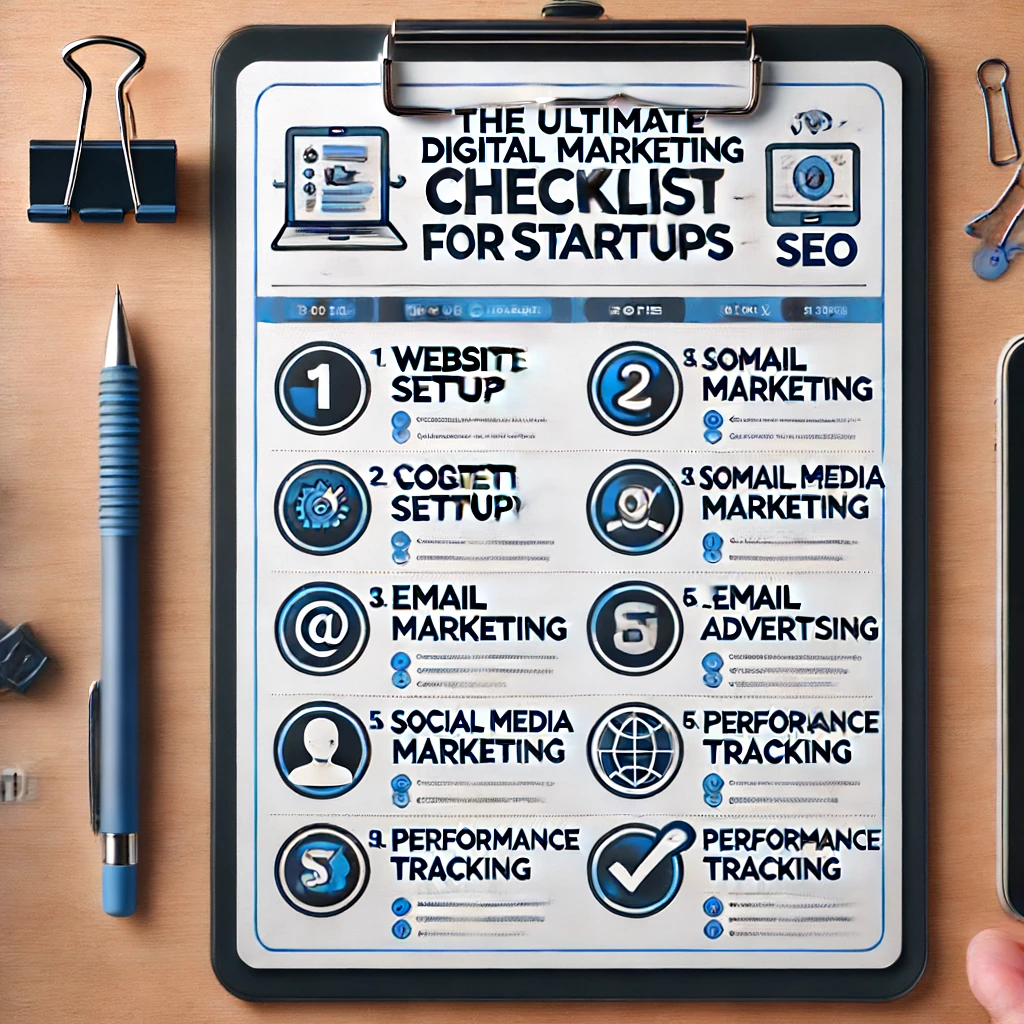Starting a new business is an exciting journey, but navigating the digital marketing landscape can be overwhelming for startups. This comprehensive guide will help you develop a robust digital marketing strategy to build your online presence, attract customers, and drive growth. Here’s the ultimate digital marketing checklist for startups.
The Ultimate Digital Marketing Checklist for Startups
Toggle1. Website Setup
Your website is your digital storefront. It’s where potential customers learn about your products or services and make purchasing decisions. Ensuring your website is optimized for performance and user experience is crucial.
Responsive Design:
- Ensure your website is mobile-friendly. More than half of web traffic comes from mobile devices, so a responsive design is essential. Use flexible layouts, images, and CSS media queries to ensure your site looks great on any device.
SEO Optimization:
- Implement basic SEO practices. Use keywords relevant to your business and audience. Optimize title tags, meta descriptions, headers, and URLs. Use keywords like “digital marketing checklist,” “startup marketing,” and “small business marketing” to help your site rank higher in search engine results.
Analytics Setup:
- Install Google Analytics to track website performance. Understanding your traffic sources, user behavior, and conversion rates is critical for making data-driven decisions.
Fast Loading Speed:
- Optimize images and use caching to improve loading times. Compress images without sacrificing quality and leverage browser caching to store static files, reducing load times for returning visitors.
2. Content Marketing
Content is king in digital marketing. High-quality, relevant content attracts and engages your audience, establishes your authority in your industry, and drives organic traffic to your website.
Blog Posts:
- Publish regular, high-quality content relevant to your industry. Aim for informative, engaging, and valuable posts that address your audience’s pain points and interests.
Guest Blogging:
- Write for other websites to increase your reach. Guest posts on reputable sites can drive traffic to your site and build your authority.
Content Calendar:
- Plan your content ahead of time to maintain consistency. Use a content calendar to schedule posts, ensuring a steady flow of content.
3. Social Media Marketing
Social media platforms are powerful tools for reaching and engaging with your audience. They provide opportunities for brand building, customer service, and driving traffic to your website.
Profile Optimization:
- Complete and optimize profiles on platforms like Pinterest, Instagram, and LinkedIn. Use consistent branding, including logos, cover images, and bios that reflect your brand’s personality and values.
Regular Posting:
- Maintain a consistent posting schedule. Use a social media calendar to plan and schedule posts in advance, ensuring you maintain a regular presence.
Engagement:
- Respond to comments and messages promptly. Engage with your audience by liking, sharing, and commenting on their posts. This fosters a community around your brand.
Analytics:
- Monitor social media metrics to gauge performance. Use insights from each platform to understand what content resonates with your audience and adjust your strategy accordingly.
4.Email Marketing
Email marketing remains one of the most effective digital marketing strategies. It allows you to nurture leads, build relationships with customers, and drive conversions.
Email List Building:
- Use sign-up forms and lead magnets to grow your email list. Offer valuable content or incentives (e.g., eBooks, discounts) in exchange for email subscriptions.
Newsletter Creation:
- Send regular newsletters with valuable content. Share company news, blog posts, special offers, and other relevant information to keep your audience engaged.
Personalization:
- Segment your email list and personalize your emails. Use segmentation to send targeted messages based on user behavior, preferences, or demographics.
A/B Testing:
- Test different email elements to improve open and click rates. Experiment with subject lines, email designs, call-to-actions, and send times to find what works best for your audience.
5. Paid Advertising
Paid advertising can help you reach a larger audience quickly. It’s essential for startups looking to increase brand awareness and generate leads.
Google Ads:
- Set up and optimize campaigns targeting your audience. Use keyword research to identify terms your potential customers are searching for and create ads that drive traffic to your website or landing pages.
Social Media Ads:
- Run ads on platforms where your audience is most active. Use Facebook, Instagram, LinkedIn, and other platforms to reach your target market. Utilize the advanced targeting options these platforms offer to reach specific demographics, interests, and behaviors.
Retargeting:
- Use retargeting ads to re-engage visitors who didn’t convert. Display ads to people who have visited your website or interacted with your brand but haven’t made a purchase yet. This keeps your brand top-of-mind and encourages them to return and convert.
6. Search Engine Optimization (SEO)
SEO is a long-term strategy that can significantly boost your online visibility and drive organic traffic to your website.
Keyword Research:
Identify and use relevant keywords in your content. Tools like Google Keyword Planner, SEMrush, and Ahrefs can help you find keywords that your target audience is searching for.
On-Page SEO:
- Optimize title tags, meta descriptions, headers, and URLs. Make sure each page on your website is optimized for a specific keyword and provides value to your visitors.
Backlink Building:
- Get high-quality backlinks to improve your site’s authority. Reach out to industry influencers, write guest posts, and create valuable content that others want to link to.
Local SEO:
- Optimize for local search if applicable. Ensure your business is listed on Google My Business and other local directories. Use local keywords and encourage satisfied customers to leave positive reviews.
7. Performance Tracking
Monitoring your digital marketing efforts is crucial to understand what’s working and what’s not. Use this data to continuously refine your strategies.
KPIs:
- Define and track key performance indicators. KPIs might include website traffic, conversion rates, social media engagement, email open rates, and ROI on paid ads.
Monthly Reports:
- Create and review monthly performance reports. Analyze the data to identify trends, measure the success of your campaigns, and make informed decisions.
Adjust Strategies:
- Continuously refine your strategies based on performance data. Be agile and ready to pivot your approach based on what the data tells you. Experiment with new tactics and strategies to keep your marketing efforts fresh and effective.
Implementing the Checklist
To make the most of this checklist, implement each step methodically and track your progress. Here’s a more detailed guide on how to execute these steps:
Step 1: Prioritize Your Efforts
Not all items on the checklist will be equally important for your startup at every stage. Start by prioritizing the most critical tasks, such as setting up your website and basic SEO. As you grow, you can focus on more advanced strategies like paid advertising and detailed performance tracking.
Step 2: Allocate Resources
Digital marketing requires time, effort, and sometimes financial investment. Allocate resources effectively by setting a budget for paid advertising, investing in SEO tools, and perhaps hiring experts if necessary. You can start small and scale your efforts as your business grows.
Step 3: Set Clear Goals
Define what success looks like for your digital marketing efforts. Set SMART goals (Specific, Measurable, Achievable, Relevant, Time-bound) for each aspect of your strategy. For instance, aim to increase website traffic by 20% in the next three months or generate 50 new leads per month through social media.
Step 4: Use Tools and Automation
Leverage digital marketing tools to streamline your efforts. Tools like HubSpot, Mailchimp, Hootsuite, and Google Analytics can help you manage your campaigns, automate repetitive tasks, and track performance. Automation can save time and ensure consistency across your marketing channels.
Step 5: Continuously Learn and Adapt
Digital marketing is constantly evolving. Stay updated with the latest trends, tools, and best practices. Join online communities, attend webinars, and read industry blogs to keep your knowledge fresh. Be prepared to adapt your strategies based on new insights and changing market conditions.
Conclusion
Digital marketing is a powerful tool for startups looking to build their brand, attract customers, and grow their business. By following this comprehensive checklist, you can ensure that your digital marketing efforts are effective and aligned with your business goals.
Remember, digital marketing is not a one-time effort but an ongoing process. Continuously monitor your performance, learn from your successes and failures, and adapt your strategies to stay ahead of the competition.
Implementing this ultimate digital marketing checklist will set your startup on the path to success. Happy marketing!

